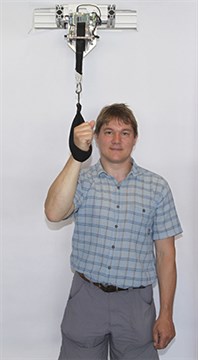 Background
Background
In Denmark, around 12,500 people are being admitted to hospital each year as a result of apoplexy (cerebral thrombosis or cerebral haemorrhage). Apoplexy is the most common cause of disability in adulthood, and about half of these people sustain permanent damage. In addition to the enormous human costs caused by apoplexy, the estimated annual treatment and care expenditure amounts to 2.7 billion DKK.
About RoboTrainer Light
RoboTrainer Light (RTL) consists of a cord, which is connected to a motor. When the patient pulls the cord, the engine compensates for the weight of the arm, and the patient can thus train his/her muscles by own force, in spite of not being able to actually lift his/her arm. This is comparable to moving one's arms when one's body is fully covered by water in a swimming pool. In such instances some force is required, although one's arms are held up by themselves.
Rehabilitation studies have revealed that numerous repetitions of training exercises are an effective way to help the brain to learn to control paralysed muscle groups, so that patients can gradually recover their functional ability. Depending on the nature of the functional impairment, the patient is often not able to perform exercises without the help of therapists.
RTL registers the history of the training, such as frequency, duration, level, which makes it easier to measure and monitor the progress of the training and visualise the results.
Training history can help therapists adjust exercise levels as well as motivate patients to train due to the ease of seeing even small progresses.
Purpose/vision
The aim of the research project is to develop and test the RTL in cooperation with health professionals and patients. The robot must be so easy to use that therapists can create individual training programmes for individual patients, for example by selecting exercises, adjusting levels of difficulty, training intervals, etc.
Eventually, some patient groups may do the exercises on their own - in hospital, in the municipal gym and at home.
Results
The simple structure makes the robot both inexpensive to manufacture and easy to use. Since the training can take place in different locations, the robot can follow the patient throughout the training process from hospital via the municipal training centre to the patient's own home. Expectations are that good and consistent training will benefit not only the patients but also have socio-economic advantages.
The intention is to conduct a qualitative study of the user (patients and staff) experience of the RTL and the financial and organizational implications of the use of the RTL. It is expected that the RTL will be commercialized in the near future.
Read more HERE.